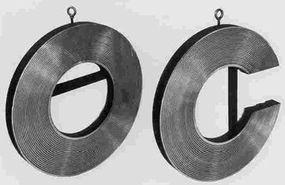If you have ever rolled a couple of those little metal balls found in a ball bearing around in your hand, you have noticed how perfectly round and incredibly smooth they feel. You might have wondered how anything could be made that perfect. It's actually a pretty neat process that starts with a metal wire and ends with a perfect shiny ball.
The first stage in the process is a cold or hot forming operation. A wire of metal approximately the diameter of the finished ball is fed through a heading machine. This machine has a metal cavity the shape of a hemisphere on each side. It slams shut on the wire forcing the piece of metal into the shape of a ball. The process leaves a ring of metal (called flash) around the ball, so the balls coming out of this machine look something like the planet Saturn.
Advertisement
Next the balls go into a machine that removes the flash. This machine rolls the ball between two very heavy hardened steel plates called rill plates.

One rill plate is stationary and the other one spins. The plates have grooves machined into them that guide the balls around in a circular path. You can see that one of the plates has a section cut out of it; this is where the balls enter and exit the grooves. When the machine is running, the grooves are completely filled with balls. Once a ball has traveled through a groove, it falls into the open section in the plate and tumbles around for a little while before entering a different groove. By making sure the balls travel through many different grooves, all the balls will come out of the machine the same size even if there are differences between the grooves.
As the ball travels through the groove, it spins and tumbles, the rough edges get broken off, and the ball gets squeezed into a spherical shape, a little like rolling a ball of dough between your hands. This squeezing of the balls compresses the metal, giving the balls a very hard surface. Because the balls are metal, this operation generates a lot of heat, so water pours over the balls and plates to cool them.
The variables in this process are the pressure that squeezes the plates together, the speed the plates spin and the duration the balls are left in the machine. Properly setting these variables will consistently produce balls of the correct size.
After this operation the balls may be heat-treated. This hardens the balls, but it also changes their size. The size of bearing balls has to be perfect, sometimes within millionths of an inch, so a few more operations are needed after heat-treating.
The balls next go through a grinding operation. The same kind of machine is used, but this time the coolant contains an abrasive. The balls travel through the grooves again and get ground down and compressed to their final dimensions.
Finally the balls go through a lapping operation. Again, the same kind of machine is used, but this time the plates are made of a softer metal, and the machine uses much less pressure to squeeze the plates together. Also, the machine uses a polishing paste rather than an abrasive. This process gives the balls their perfect smooth shiny surface, without removing any more material.
The last step in the process is inspection. The balls are measured with very accurate machinery to determine if they meet the required tolerances. For instance, the Anti-Friction Bearing Manufacturers Association (AFBMA) has a set of grades for bearing balls. A grade three ball has to be spherical within 3 millionths of an inch and the diameter must be accurate within 30 millionths of an inch. This means that for a grade three quarter-inch ball, the diameter would have to be between 0.24997 and 0.25003 of an inch and the smallest diameter measured on the ball has to be within 3 millionths of the largest diameter.
Manufacturers use a very similar process to make metal pellets for air guns, plastic balls for bearings and even the plastic balls used in roll-on deodorant.
Here are some interesting links:
Advertisement
